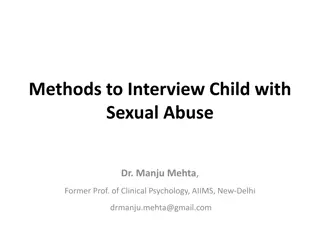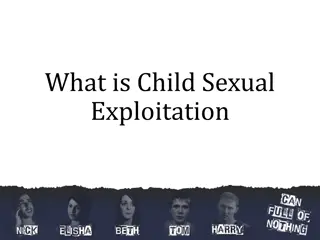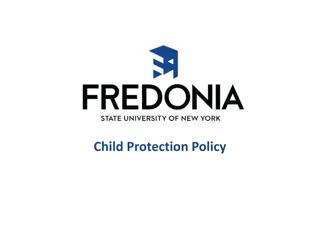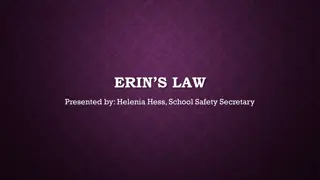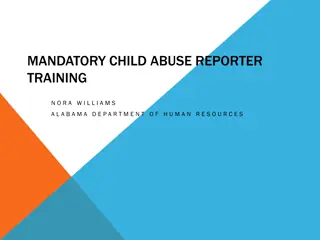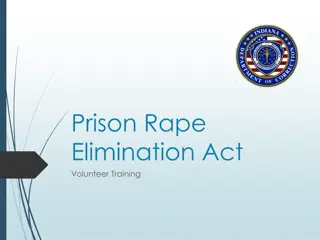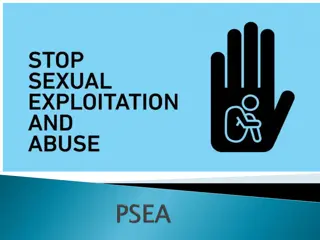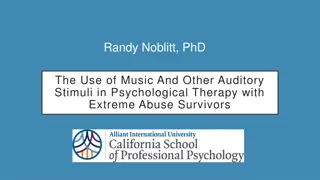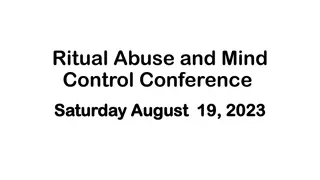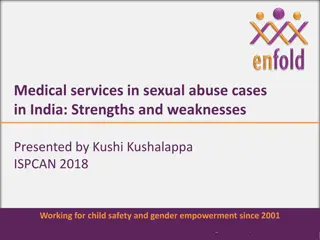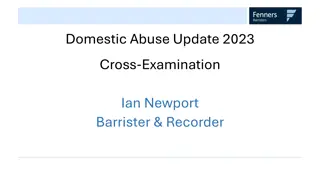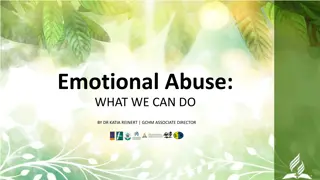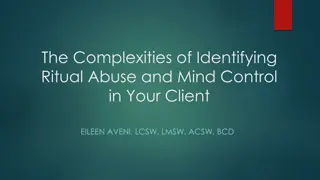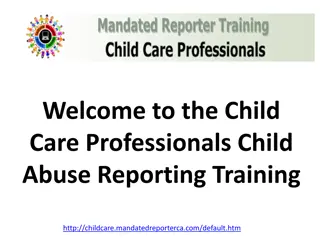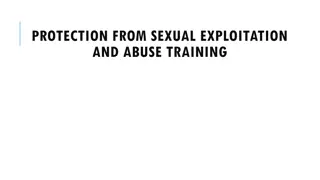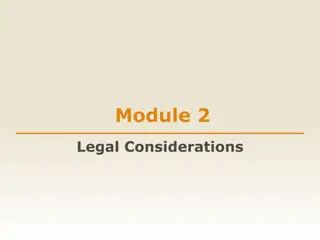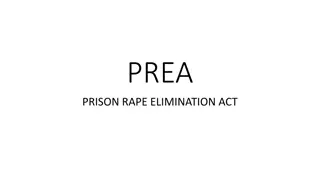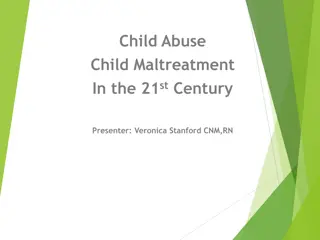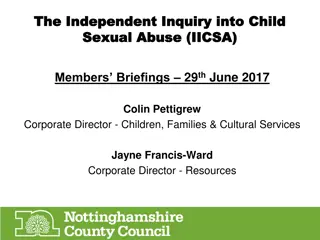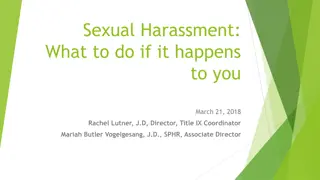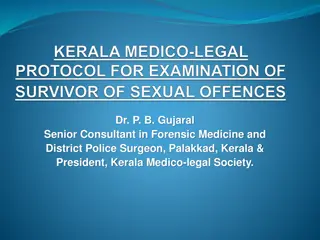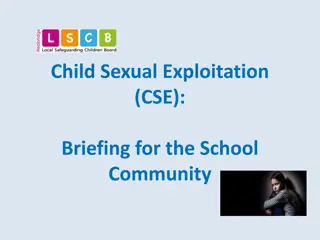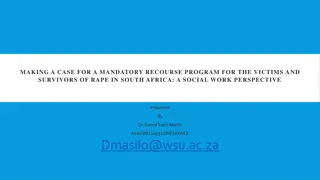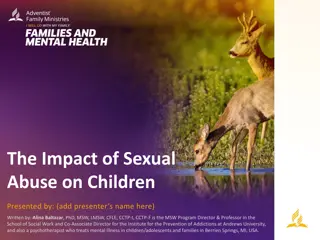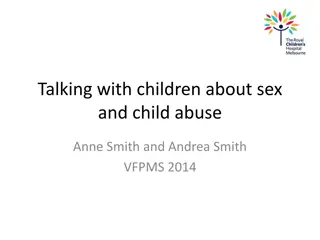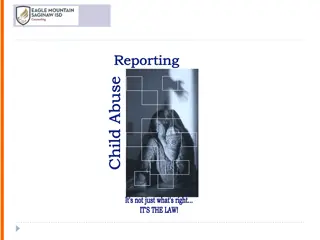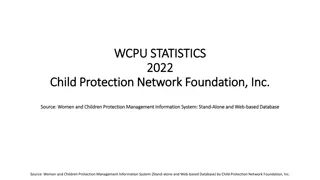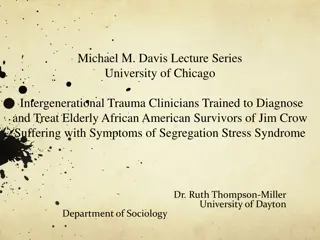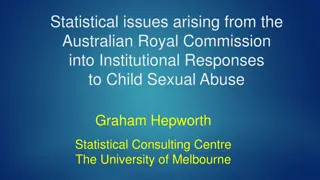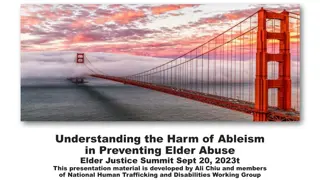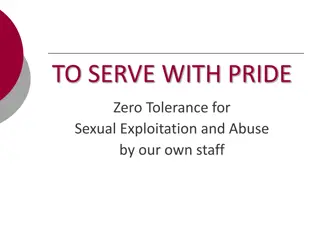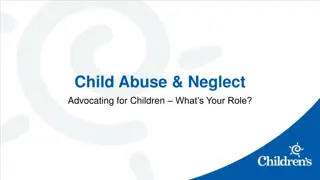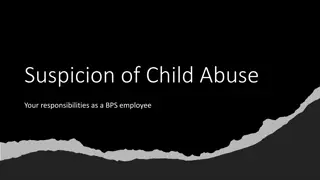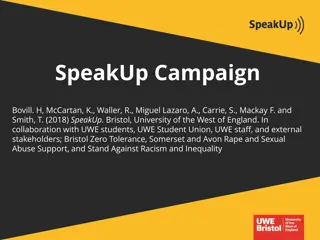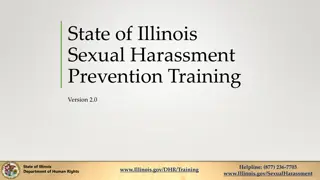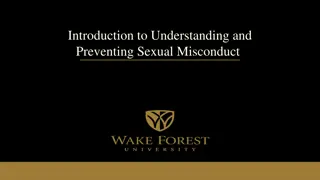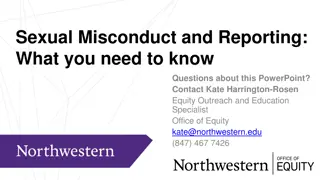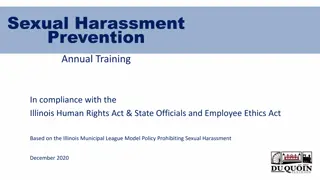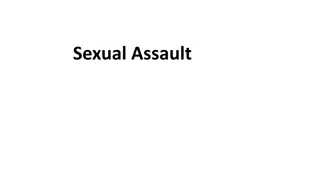Effective Communication Strategies for Engaging with Child Survivors of Sexual Abuse
Learn about the best practices and strategies for communication sessions aimed at engaging and communicating with child survivors of sexual abuse. Understand the importance of good communication, the challenges children may face post-abuse, and the consequences of using bad interview practices. Enhance your skills to help children trust, feel safe, and manage their emotions effectively through communication.
Download Presentation

Please find below an Image/Link to download the presentation.
The content on the website is provided AS IS for your information and personal use only. It may not be sold, licensed, or shared on other websites without obtaining consent from the author. Download presentation by click this link. If you encounter any issues during the download, it is possible that the publisher has removed the file from their server.
E N D
Presentation Transcript
Communication best practice & strategies
Session outline Overall purpose of the communication sessions What is communication? Why good communication is important Activity: How easy is it? Communication best practice
Overall purpose of communication sessions
Overall purpose of communication sessions Participants demonstrate knowledge and improved skills in engaging and communicating with child survivors of sexual abuse
What is communication?
What is communication? Conveying information through exchange of thoughts, using linguistic or non-linguistic forms e.g. speech, visuals, signals, writing, or behavior - One person gives information, another receives the information - May be intentional or unintentional Giving information about person's needs, desires, perceptions, knowledge, or affective states
Why good communication is important
Sexual abuse can interfere with a childs development. After sexual abuse, children may find it hard to: Trust people Feel safe with adults Adjust back to daily life Communicate with others Understand & manage feelings All communication should aim to address these common difficulties
What will happen if you interview children using bad practice? Children will stop talking to you Children may deny the abuse happened Children will feel worse and will suffer more Children will tell different people different things Children will be re-traumatized meaning they will be further damaged emotionally & psychologically from being treated poorly by an adult in charge
Communication for helping relationships Goal of communication between service provider & child is to establish a trusting, safe & supportive helping relationship
The helping relationship Empowers child & caregiver(s) to feel cared for & respected by service provider Every meeting with child survivor & family members is an opportunity for service providers to strengthen helping relationship
How easy is it? Easy Hard
Communication best practice
Best practice for communicating Be comforting & supportive Do no harm Be reassuring Talk in a way children will understand Tell children why you are talking to them Help the child feel safe Respect children s thoughts & beliefs Pay attention to non-verbal communication Use appropriate interviewers
To be applied to the following types of interviews Forensic interviews conducted by health workers or police Medical interviews conducted by health workers Child intake and assessment interviews (with child & family) conducted by case workers
Group work Each assigned one of the best practice points Think of ways you can convey the best practice point - Content of what you say / words used - Voice tone, pitch, volume, etc. - Body language - Other actions you can take, explanations, choice of location, etc. 10 mins 3 mins each group to present
1. Do no harm be careful not to cause further distress Monitor interactions that can distress child Do not become angry Do not force to answer questions, or do anything Do not require they repeat story numerous times Limit activities & communication that cause distress
2. Be comforting & supportive Child will likely be referred via a caregiver or adult. When referred Be positive, supportive & calm Show you believe the child Show friendly body language Ask child when and where, and with whom they would like to talk Ask if they prefer other way of communicating
3. Be reassuring Reassure child that it was not their fault & you believe them Tell them they are brave for sharing their story, there is no blame or shame Emphasize you are their to help begin the healing process Tell them the feelings they have are normal
4. Help the child feel safe I Space - Safe & comfortable for child. Private, quiet, free from distraction & potential danger Position - At same height / level - Close enough so s/he does not have talk loudly, but also feels safe - Where s/he can see door
Help the child feel safe II Offer choice of having trusted adult they know with them during interview or not Do not force child to speak to or in front of someone they appear not to trust Do not include the person suspected of abusing the child Tell the truth even when it is difficult
5. Talk in a way children will understand I Present information in language they understand, alter your vocabulary Ensure it is adapted to age and stage of development Use variety of means of communicating You will need to ask sensitive questions that s ok
Talk in a way children will understand II Explain questions dealing with sensitive issues to put child s fears at ease Tell the child you know this is difficult & they can go slowly Ask the child clear & simple questions, focusing on the last time the incident occurred
6. Tell children why you are talking with them Who you are and the purpose of the interview How long the interview will take Who the translator is, if one is being used Why you are writing information down (if you are) Let the child have a trusted adult in the room if he or she would like to
7. Use appropriate interviewers Best practice is to ask child if s/he would prefer male or female staff to talk to Ensure staff member is trained on how to communicate with child survivors Interviewer must be aware of any information or concerns already known about the case Interviewed must know what services are available to the child must not make promises of support they cannot keep
8. Pay attention to non verbal communication I Maintain positive body language to ensure comfort and trust - Maintain eye contact where culturally appropriate - Use warm / comforting body language - Avoid touching the child unless this is appropriate to convey warmth
Pay attention to non verbal communication II Pay attention to the child s body language Children may demonstrate signs of physical distress that could signal need to pause the interview: - Crying - Shaking head - Changing posture / turning away - Curling into ball
9. Respect childrens thoughts and beliefs Children have right to express opinions, thoughts & beliefs about what happened & decisions being made Service providers must communicate to children that they have this right Empower child to be in control during communication Child has right NOT to participate: - Child free to answer I don t know or stop speaking, at any time
Key points Children who have experienced abuse may find it extremely difficult to talk to others about it Good communication from beginning ensures child survivor willing to engage further, & enables service provider to offer appropriate care and treatment Communication must demonstrate empathy & belief, build trust, create feeling of safety & support



